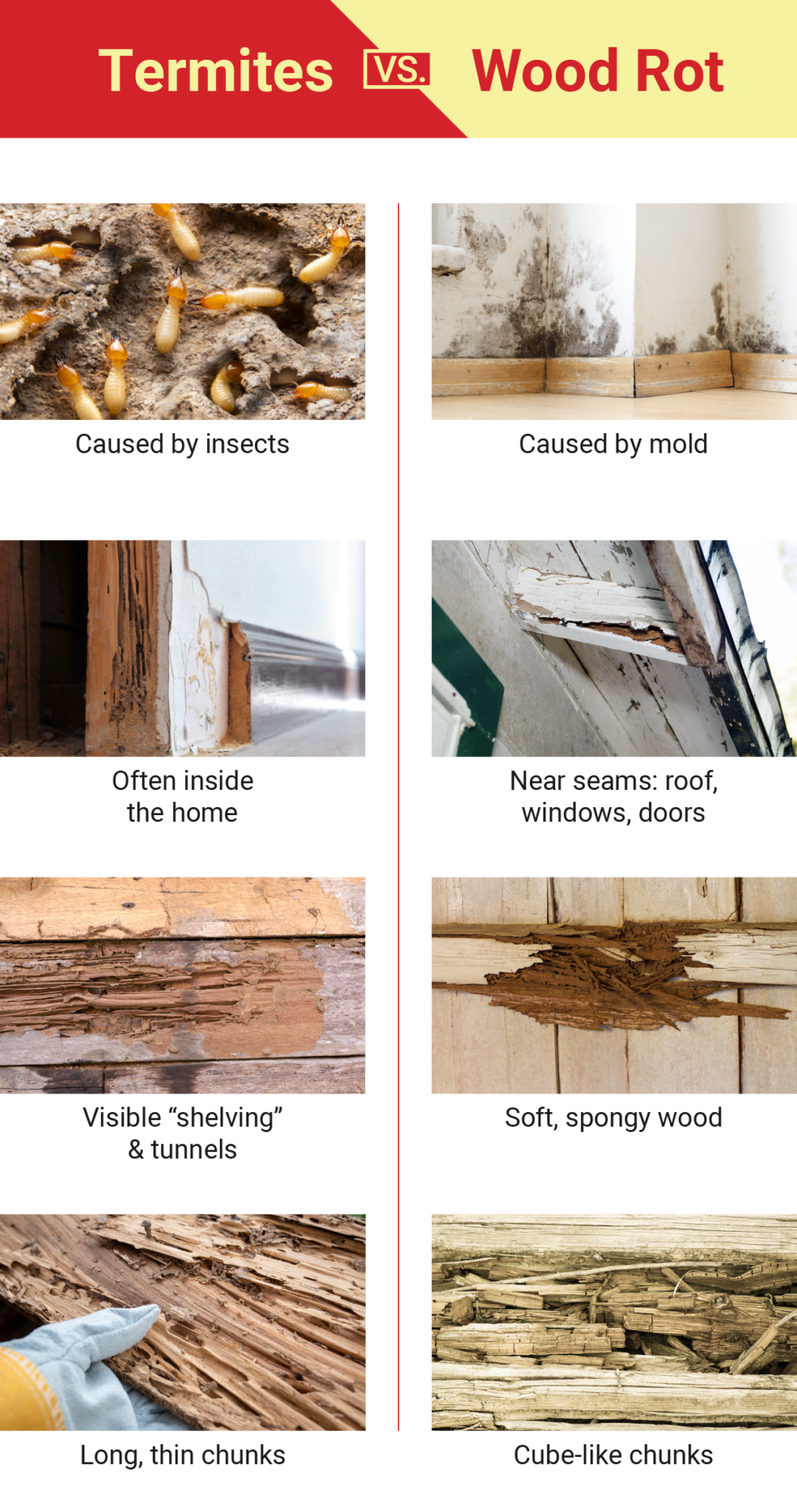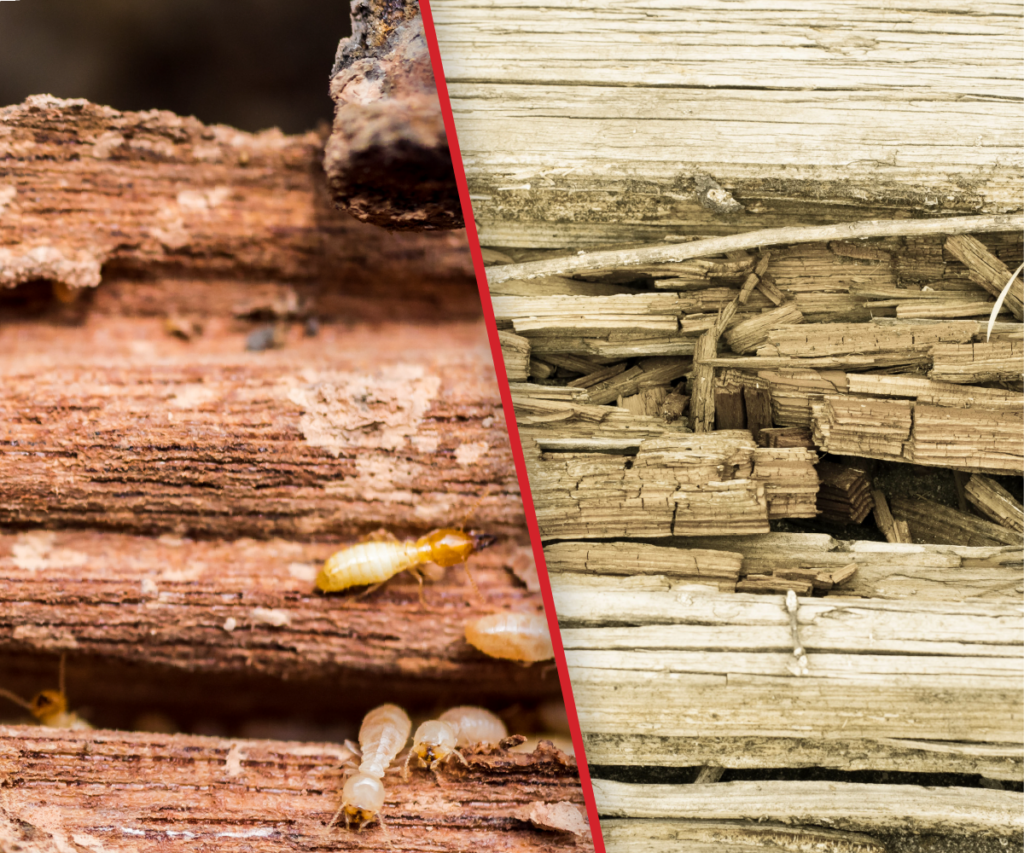Termites and wood rot are two common problems that homeowners may face when it comes to the deterioration of wooden structures. Although both can cause significant damage, they differ in their causes, signs, and treatment methods. Understanding the differences between termite damage and wood rot is essential for homeowners to identify the problem accurately and take appropriate action to protect their valuable assets.
Termites are tiny insects that feed on wood, causing structural damage that can be extremely costly to repair. These pests are often referred to as “silent destroyers” because they can chew through wood without any visible signs on the surface. On the other hand, wood rot is a natural process caused by fungi that break down the cellulose and lignin in wood, resulting in decay. Unlike termites, wood rot is often visible, with signs such as discoloration, soft or crumbling wood, and a distinct musty smell. By understanding the characteristics of termite damage and wood rot, homeowners can identify the signs and determine the most effective course of action to prevent further deterioration and protect their property.
Termite Damage vs Wood Rot
Termite damage and wood rot are both common issues that can affect the structural integrity of wood. While termite damage is caused by the feeding and tunneling of termites, wood rot is caused by the decay of wood due to moisture and fungi. Here’s a comparison table to help you understand the differences:
| Termite Damage | Wood Rot |
|---|---|
| Caused by termites feeding and tunneling | Caused by decay due to moisture and fungi |
| Can weaken the wood structure | Causes wood to become soft and crumbly |
| Can be prevented with termite treatments | Can be prevented by addressing moisture issues |

Termite Damage vs Wood Rot
Termites and wood rot are two common problems that can damage wooden structures. While they may seem similar, there are distinct differences between termite damage and wood rot. Understanding these differences is essential for proper identification and treatment. This article will provide a comprehensive guide on termite damage and wood rot, outlining their causes, signs, prevention, and treatment methods.
Causes of Termite Damage
Termite damage is primarily caused by the activity of termites, which are small, social insects that feed on wood. Termites are attracted to moisture and cellulose, which is found in abundance in wooden structures. They can enter buildings through small cracks or gaps in the foundation and begin feeding on the wood. Over time, this feeding activity weakens the structure, leading to structural damage.
Termites are particularly prevalent in areas with warm and humid climates. They form large colonies and work together to feed on wood, making it difficult to detect their presence until significant damage has already occurred.
Signs of Termite Damage
Identifying termite damage can be challenging, as it is often hidden from plain sight. However, there are some telltale signs that can indicate the presence of termites. These include:
- Visible mud tubes on walls or foundation
- Hollow-sounding wood when tapped
- Discarded wings near windows or doors
- Presence of termite droppings (frass)
- Warped or buckling wooden surfaces
If any of these signs are observed, it is crucial to take immediate action to prevent further damage.
Prevention and Treatment of Termite Damage
Preventing termite damage starts with taking proactive measures to deter termites from entering a structure. This includes:
- Regularly inspecting the foundation and walls for cracks or gaps
- Keeping the area around the structure free from wood debris
- Ensuring proper drainage to prevent excess moisture
- Applying termite repellents or treatments as a preventive measure
If termite damage is already present, professional assistance should be sought. Treatment methods may include the application of chemical barriers, baiting systems, or fumigation, depending on the severity of the infestation.
Causes of Wood Rot
Wood rot, on the other hand, is caused by the growth of fungi on wood. Fungi thrive in damp environments, and when wood is exposed to moisture for extended periods, it provides an ideal habitat for fungal growth. Common causes of wood rot include:
- Leaky roofs or plumbing
- Poorly ventilated areas
- Excessive humidity
- Improperly treated or unprotected wood
Wood rot can occur in both indoor and outdoor environments and is often more noticeable than termite damage due to its characteristic appearance.
Signs of Wood Rot
Identifying wood rot is relatively straightforward, as it typically presents visible signs. These signs include:
- Soft, spongy, or crumbly wood
- Discoloration or darkening of the wood
- Presence of fungal growth or fruiting bodies
- Musty or earthy odor
If wood rot is left untreated, it can compromise the structural integrity of the wood, leading to potential safety hazards.
Prevention and Treatment of Wood Rot
Preventing wood rot involves addressing the underlying causes and ensuring proper maintenance of wooden structures. Some preventive measures include:
- Regularly inspecting and repairing leaking roofs or plumbing
- Improving ventilation in damp areas
- Applying wood preservatives or sealants to protect against moisture
- Removing any decaying wood promptly
If wood rot is already present, treatment may involve removing the affected wood and replacing it with new, treated wood. In severe cases, professional assistance may be required to assess the extent of the damage and provide appropriate solutions.
In Conclusion
Understanding the differences between termite damage and wood rot is crucial for effective identification and treatment. While both can cause significant damage to wooden structures, their causes, signs, prevention, and treatment methods vary. By being proactive in prevention and seeking professional assistance when necessary, it is possible to mitigate the risks associated with termite damage and wood rot, ensuring the longevity of wooden structures.
Frequently Asked Questions
Here are some commonly asked questions about termite damage vs wood rot:
What is termite damage?
Termite damage refers to the destruction caused to wooden structures by termites. Termites are small insects that feed on wood and other cellulose-containing materials. They can cause significant damage to buildings, furniture, and other wooden items. Termite damage often goes unnoticed until it becomes severe, as termites tend to stay hidden within the wood. If left untreated, termite damage can compromise the structural integrity of a building.
It is important to identify and address termite damage as early as possible to prevent further destruction. Regular inspections by professionals can help detect termite infestations and mitigate the damage caused by these pests.
What is wood rot?
Wood rot, also known as decay or fungal decay, is a process where wood deteriorates due to the growth of fungi. It occurs when moisture or high humidity levels are present, creating an ideal environment for fungal growth. Wood rot can affect both indoor and outdoor wooden structures, including furniture, decks, and structural beams.
The decay caused by wood rot weakens the wood’s structure and can make it brittle, leading to potential safety hazards. It is important to address wood rot promptly by identifying and removing the affected areas, improving ventilation to reduce moisture levels, and treating the wood with appropriate fungicides to prevent further decay.
How can I differentiate between termite damage and wood rot?
Differentiating between termite damage and wood rot can be challenging, as they can have similar visual characteristics. However, there are a few key differences to look out for:
Termite damage often appears as hollowed-out or damaged wood with mud tubes or tunnels on the surface. The wood may have a honeycomb-like appearance, with galleries or tunnels running through it. On the other hand, wood rot typically causes the wood to become soft, spongy, and discolored. It may show signs of fungal growth, such as mold or mushrooms.
If you are unsure about the type of damage present, it is recommended to consult a professional pest control or wood restoration specialist who can assess the situation and provide appropriate solutions.
Can termite damage lead to wood rot?
While termite damage and wood rot are distinct issues, they can be interconnected. Termite infestations can create conditions favorable for wood rot to occur. Termites produce moisture as they feed on wood, and this excess moisture can contribute to the growth of fungi that cause wood rot.
If termite damage is left untreated, the compromised wood can become more susceptible to wood rot. The combination of termite activity and wood rot can significantly weaken the structure and integrity of the wood, making it more prone to collapse or further damage.
Therefore, it is crucial to address termite infestations promptly and take preventive measures to minimize the risk of wood rot.
How can I prevent termite damage and wood rot?
Prevention is key when it comes to termite damage and wood rot. Here are some preventive measures you can take:
1. Regular inspections: Schedule regular inspections by pest control professionals to detect and address termite infestations at an early stage.
2. Moisture control: Maintain proper ventilation and moisture levels to prevent the growth of fungi that cause wood rot. Fix leaks and ensure proper drainage around the structure.
3. Remove wood-to-soil contact: Avoid direct contact between wooden structures and the soil, as it can provide easy access for termites. Use concrete or metal barriers to create a gap between the wood and the ground.
4. Treat and protect the wood: Apply appropriate wood treatments and coatings to protect against termites and wood rot. Regularly inspect and maintain wooden structures, repairing any damage promptly.
By implementing these preventive measures, you can reduce the risk of termite damage and wood rot, preserving the integrity and longevity of your wooden structures.

Is That Termite Damage? Wood Rot Damage? 😨 How to Tell the Difference
In conclusion, understanding the differences between termite damage and wood rot is crucial for maintaining the integrity and longevity of wooden structures. While both can lead to significant damage, termite infestations pose a unique and particularly destructive threat. Termites are relentless as they consume wood from the inside out, often leaving no visible signs until the damage is extensive. On the other hand, wood rot is caused by the growth of fungi, which breaks down the cellulose in wood and weakens its structural integrity over time.
To effectively combat these issues, it is essential to be proactive in prevention and detection. Regular inspections by professionals can help identify early signs of termite infestations or wood rot, allowing for swift action to mitigate the damage. Utilizing appropriate treatments, such as termite-resistant wood or applying fungicides, can also serve as preventive measures. Furthermore, maintaining proper ventilation and moisture control to minimize the risk of wood rot can significantly extend the lifespan of wooden structures.
In the battle against termite damage and wood rot, knowledge is power. By understanding the characteristics and signs of these two threats and implementing preventive measures, individuals can protect their investments and ensure the longevity of their wooden structures. Remember, early detection and appropriate treatment are key to preserving the beauty and functionality of wood for years to come.
- How to Remove Glue From Wood Floor - April 14, 2024
- How to Dissolve Wood Glue - April 14, 2024
- How to Remove Wood Glue - April 14, 2024